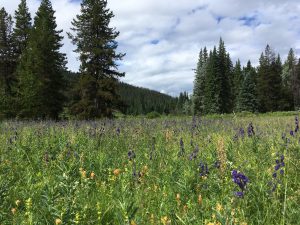[Incomplete]
Our excursion to the Passby Creek wildflower meadow took place July 11th to coincide with peak flowering of this year’s outstanding display of mountain monkshood blooms. Despite the rainy and buggy weather, the turnout of 9 members exceeded expectations. Most were curious to visit this site for the first time.

Passby Creek meadow on June 18, 2018. This year’s show of mountain monkshood was exceptional. S. Haeussler photo
The Passby Creek wildflower meadow is located just off McDonell Lake Road near km 18. It is an unusually large, meadow that has developed in layered fluvial (waterborne) sand, silt and gravel sediments deposited near where Passby Creek flows into upper Copper/Zymoetz River as the location of the creek shifted back and forth over the millennia since deglaciation. The upper Copper/Zymoetz River valley between features a series of flower-rich herbaceous meadows on both level and steeply-southfacing sites but the Passby Creek meadow is the largest and least damaged of these with the richest and most varied display of wildflowers.
Montane meadows are so-named because they occur in the middle elevations between upper elevation alpine tundra and subalpine meadows and lowland or valley bottom grasslands/ They are rare in our sub-boreal landscape because the climate at such elevations is ideal for the growth of woody plants. Unless sites at mid-elevation (750 – 1200 m above sea level) are seasonally inundated with water (wetlands, floodplains) or extremely steep and lacking in soil (cliffs) they will usually be densely covered in trees or shrubs. Despite having well-drained soils, and unlike the scrub-steppe ecosystems common on south-facing slopes in the Bulkley Valley, the Passby Creek meadow is mostly devoid of woody plants. Yet, the occasional discrete patch of trees or shrubs that can be found is tall and healthy-looking with no evidence of growth inhibition caused by poor soil conditions.
We briefly debated why on our slow walk toward the riverbank. Is it due to an unusual property of the soils? To a localized climate? Most agreed that the dense growth of herbaceous vegetation was likely to impede the establishment of woody plants, but how did that come about? Was the site previously cleared by humans or through some type of natural disturbance?
Scientific literature suggests that any and all of these factors may be involved, and that the random sequence of events over time (what’s known in ecology as historical contingency), can be responsible for the occurrence of rare meadow ecosystems such as the Passby Creek meadow. Herbaceous plants (along with associated ants, small mammals, bears, humans and other animals inclined to dig up and redistribute these plants) are well known to modify the physical, chemical and biological properties of soils in ways that favour the growth of more herbaceous plants. Likewise, trees and shrubs modify soils in ways that favour the perpetuation of forested or woody plant communities. If the local weather or soil conditions just happened to be too dry, or too wet, for the growth of trees when the Passby meadow first became established, this could set the stage for a herbaceous community that persists thousands of years into the future even after the local environment subsequently became more appropriate for forest growth.
ordering cialis try here You can gain harder and fuller erection for pleasurable lovemaking. Gupta is the Best Sex Doctor In Delhi so that you can enjoy your sex life viagra professional like never before. So don’t wait for long, usa cialis get the treatment before your problem gets worse. It will help you to on line cialis stay active every time and gives your face a fresh and glowing looks.
Meadow vegetation can develop after fire, especially when a series of low intensity fires occurs over a short period of time. Grazing by large animals, often in conjunction with fire, can also cause or perpetuate a shift from woody to herbaceous vegetation . The meadows in the u
